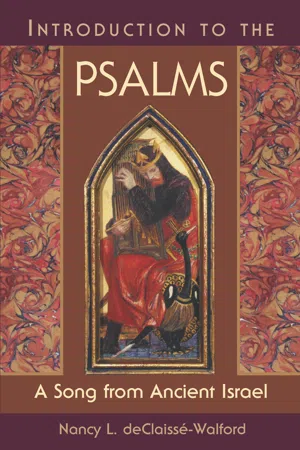![]()
1
What Words Are We Reading?
The Psalter is written in poetry rather than prose. How do we recognize poetry and how do we read it? Compare the following two passages:
The library of Brown Middle School wants to encourage each student to check out and read at least twelve books during the upcoming school year. Imagine traveling to different times and places and meeting new and interesting people without spending a penny—what a great way to broaden your horizons, make you aware of the many possibilities your life holds, and help you understand other peoples’ lives! Please participate in this program during the year, and we think you will agree that reading is a wonderful way to explore your world.
There is no frigate like a book
To take us lands away,
Nor any coursers like a page
Of prancing poetry.
This traverse may the poorest take
Without oppress of toll;
How frugal is the chariot
That bears the human soul!1
The Nature of Poetry
The reader approaches prose and poetry in very different ways. The first passage above is prose. It is an invitation to students at Brown Middle School to come to the library and take advantage of a wonderful way to explore their world. The message of the second passage is the same—“Come, explore your world through books.” But the second passage is poetry. How can we tell? How do we know when we are reading poetry? One author offers the following:
As soon as we perceive that a verbal sequence has a sustained rhythm, that it is formally structured according to a continuously operating principle of organization, we know that we are in the presence of poetry and we respond to it accordingly. We respond to it…expecting certain effects from it and not others, granting certain conventions to it and not others. All our experiences with language and literature, from the time we are small children, condition that discrimination.2
We learn then to identify poetry in several ways:
1.It looks different from prose on the page. Its lines are shorter; they don’t fill the width of the page. Some lines are indented.
2.It has a certain rhythm or beat. We can describe the poem quoted above as having a 4/3 beat or rhythm:
There is no fri-gate like a book
To take us lands a-way,
Nor a-ny cour-sers like a page
Of pranc-ing po-e-try.
3.It uses metaphorical and imaginative language. A book is compared to a “frigate” in line one and a “chariot” in line seven; poetry is described as “prancing”; and the “human soul” is used as a synonym for “reader” in the last line of the poem.
Poetry in the Book of Psalms
When we open the pages of the Hebrew Bible, we see that the book of Psalms is laid out on the page differently from, say, the books of Genesis and Kings. Let’s have a look at Psalm 3.
O LORD, how many are my foes!
Many are rising against me…
But you, O LORD, are a shield around me,
my glory, and the one who lifts up my head. (3:1, 3)
In Hebrew, the lines have a recognizable rhythm, what we may call a 3/3 pattern:
yehwāh māh rab-bû ṣā-râ
rab-bîm qā-mîm cā-lâ…
we-at-tāh yehwāh mā-gēn ba ca-dî
ke-bô-dî û-mē-rîm rō-’šî
(3:2, 4; MT 3:1, 3)
And Psalm 3 uses figurative language. The Lord is a “shield” to the psalmist (v. 3); the psalmist is not afraid of “ten thousand people” (v. 6); and the psalmist calls on God to “strike all my enemies on the cheek; break the teeth of the wicked” (v. 7).
Why are the psalms written in poetry? Walter Brueggemann titles a chapter in a book on poetry,“Poetry in a Prose-Flattened World.”3 What a statement—“A Prose-Flattened World”! Brueggemann is right. Our world is full of prose. We are bombarded daily with words—words that inform, instruct, guide, dictate, and attempt to persuade us. We become numb to the bombardment, and we tune out; we ignore. But when we encounter poetry, something happens to us; we tune in; we listen; we remember—the words to a song:
We are travelers on a journey,
fellow pilgrims on the road.
We are here to help each other
walk the mile and bear the load.
I will hold the Christ-light for you
in the nighttime of your fear.
I will hold my hand out to you,
speak the peace you long to hear.4
the rhythm of a poem:
I shall be telling this with a sigh
Somewhere ages and ages hence:
Two roads diverged in a wood, and I—
I took the one less traveled by,
And that has made all the difference.5
and the imagery of a psalm:
The LORD is my shepherd, I shall not want.
He makes me lie down in green pastures;
he leads me beside still waters;
he restores my soul. (23:1–2)
Poetry draws us in, engages us, invites us to hear and remember. It is succinct, graphic, concrete. Walt Whitman wrote these words in the nineteenth century:
After the seas are all cross’d,
(as they seem already cross’d,)
After the great captains and engineers have
accomplish’d their work,
After the noble inventors, after the scientists,
the chemist, the geologist, the ethnologist,
Finally shall come the poet worthy that name,
The true son of God shall come singing his songs.6
Walter Brueggemann summarizes the matter well when he states that the power of poetry lies in its “shattering, evocative speech that breaks fixed conclusions and presses us always toward new, dangerous, imaginative possibilities.”7
Hebrew Parallelism
The Psalter of the Hebrew Bible is composed in a special type (or genre) of poetry that was common throughout the ancient Near East. In addition to containing all of the elements of poetry that are discussed above, Hebrew poetry is made up of two or three parallel line units that are connected to one another in a numbe...
